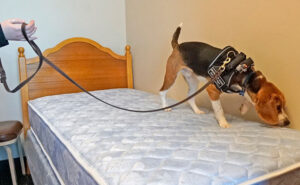
Baxter Beagle excels in her role as a bed bug inspection dog for Adam’s Pest Control, Medina, Minn. PHOTO: ADAM’S PEST CONTROL
The prevalence of bed bugs poses a significant challenge for pest management professionals (PMPs), highlighting the importance of thorough inspection practices. Early detection is crucial for effective treatment, emphasizing the importance of following a thorough and structured inspection checklist. This checklist enables PMPs to identify hotspots, assess infestation severity and tailor treatment plans accordingly. Consistency in inspection procedures is key to minimizing the risk of overlooking critical areas and enhancing assessment reliability. Below are several key steps for a comprehensive bed bug inspection:
- Gather essential information. Initiate the inspection by gathering crucial details through client interviews to understand the history of bed bug activity in the area, including recent bites, infestation duration, and suspected harborage sites.
- Prioritize safety. It is essential to equip oneself with appropriate personal protective equipment (PPE), such as gloves and knee pads, before commencing the inspection. This precaution is necessary because, during the inspection, you may come into contact with unclean areas, surfaces potentially harboring pathogens, or sharp edges while searching for bed bug-hiding spots in deep crevices or cracks where people sleep.
- Utilize tools. Incorporating tools like flashlights and multi-tools enhances bed bug detection by illuminating hidden areas and facilitating access to tight spaces, ensuring thorough inspections and effective eradication efforts.
- Direct your attention to sleeping areas. This is not only for bedrooms but for any place where individuals sleep, regardless of the mattress or sleeping surface type — couches, cribs, etc. Inspect mattresses, box springs, and furniture thoroughly, paying close attention to bed headboards, a common hiding place for bed bugs.
- Move onto other areas. If no bed bugs are found in bed-associated parts, expand the inspection to other potential hiding spots, such as upholstered furniture.
- Inspect adjacent units. If you are inspecting in a dorm, multi-family building, hospital, nursing home or other, similar facilities, conduct thorough inspections of adjacent units to prevent the spread of infestation through common walls, ceilings and doorways.
- Expect tricky hiding spots. Pay close attention to unexpected hiding spots like books, pet sleeping areas and wheelchairs, all of which are also vulnerable to bed bug infestations.
Dogs and documents
You can enhance detection accuracy by incorporating monitoring tools and trained canine detection teams into the inspection process. These tools help track infestation trends over time and distinguish between active infestations and residual signs.
Above all, maintain detailed records of all your inspection findings, treatment plans, and client interactions to ensure effective communication and accountability.
In conclusion, a structured bed bug inspection is essential for effective pest control. Prioritizing safety, using tools like flashlights and multi-tools, and conducting thorough examinations of sleeping areas and tricky hiding spots, such as pest sleeping areas and wheelchairs, are crucial steps. Consistency in procedures and the use of monitoring tools enhance accuracy. Comprehensive record-keeping ensures accountability.
Leave A Comment